Clinical Experience Reflection: Psychiatric Nursing & NMBA Standards
VerifiedAdded on 2022/10/19
|8
|2278
|181
Report
AI Summary
This report presents a reflective account of a nursing student's clinical placement experience in a psychiatric community center. The student recounts an encounter with a patient experiencing psychosis, detailing their initial fear, shock, and eventual learning process. The reflection connects this experience to two key standards of practice from the Nursing and Midwifery Board of Australia (NMBA): engaging in therapeutic and professional relationships (Standard 2) and comprehensively conducting assessments (Standard 4). The student discusses the importance of supportive supervision, effective communication, and the application of theoretical knowledge to real-world situations. The report emphasizes the significance of compassionate care, patient safety, and the development of critical thinking skills in mental health nursing. It highlights the student's personal growth, the challenges faced, and the impact of the experience on their future practice, including the importance of understanding the causes of psychosis and the role of nurses in managing it. The student's reflection is supported by relevant literature, illustrating the connection between theory and practice.
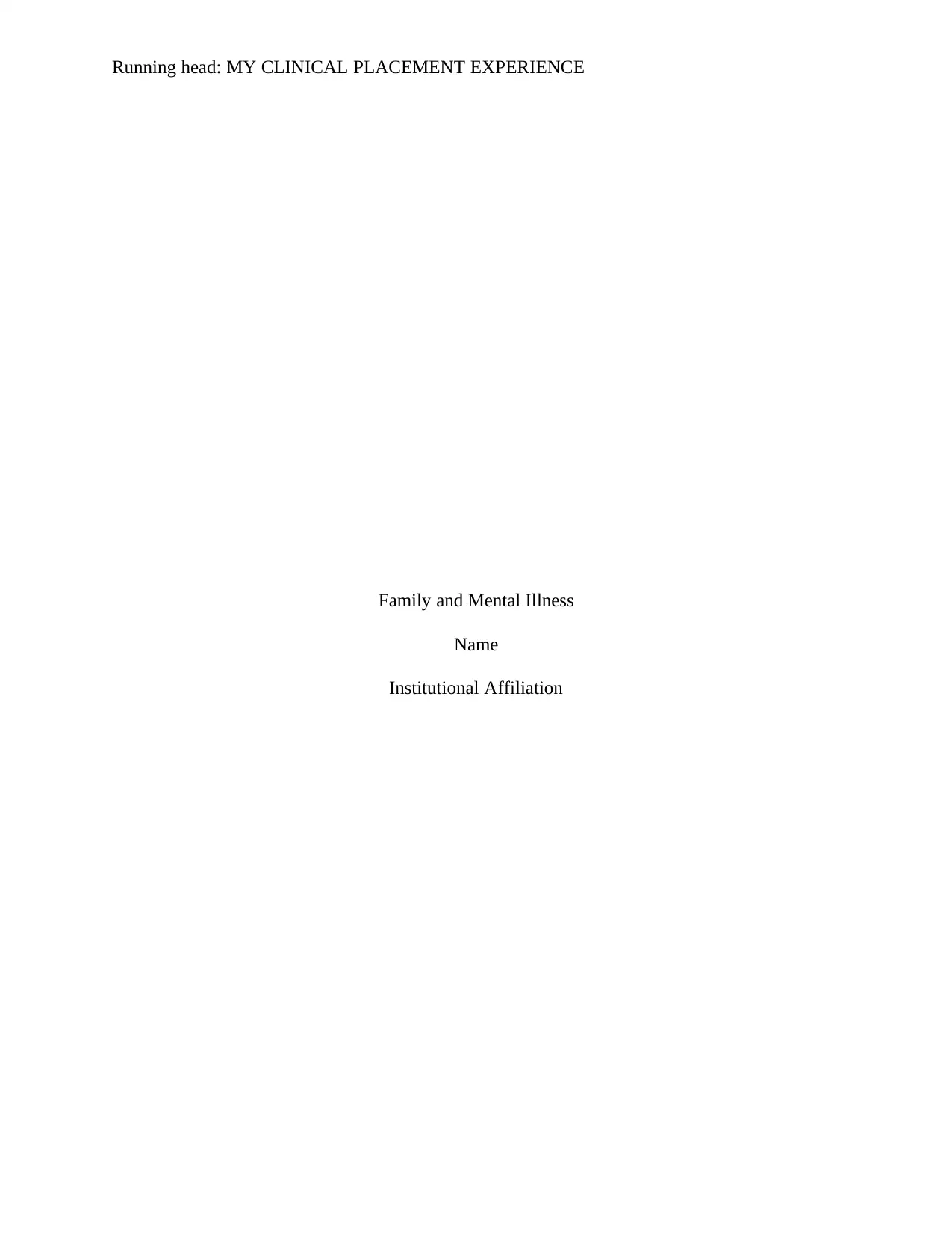
Running head: MY CLINICAL PLACEMENT EXPERIENCE
Family and Mental Illness
Name
Institutional Affiliation
Family and Mental Illness
Name
Institutional Affiliation
Paraphrase This Document
Need a fresh take? Get an instant paraphrase of this document with our AI Paraphraser
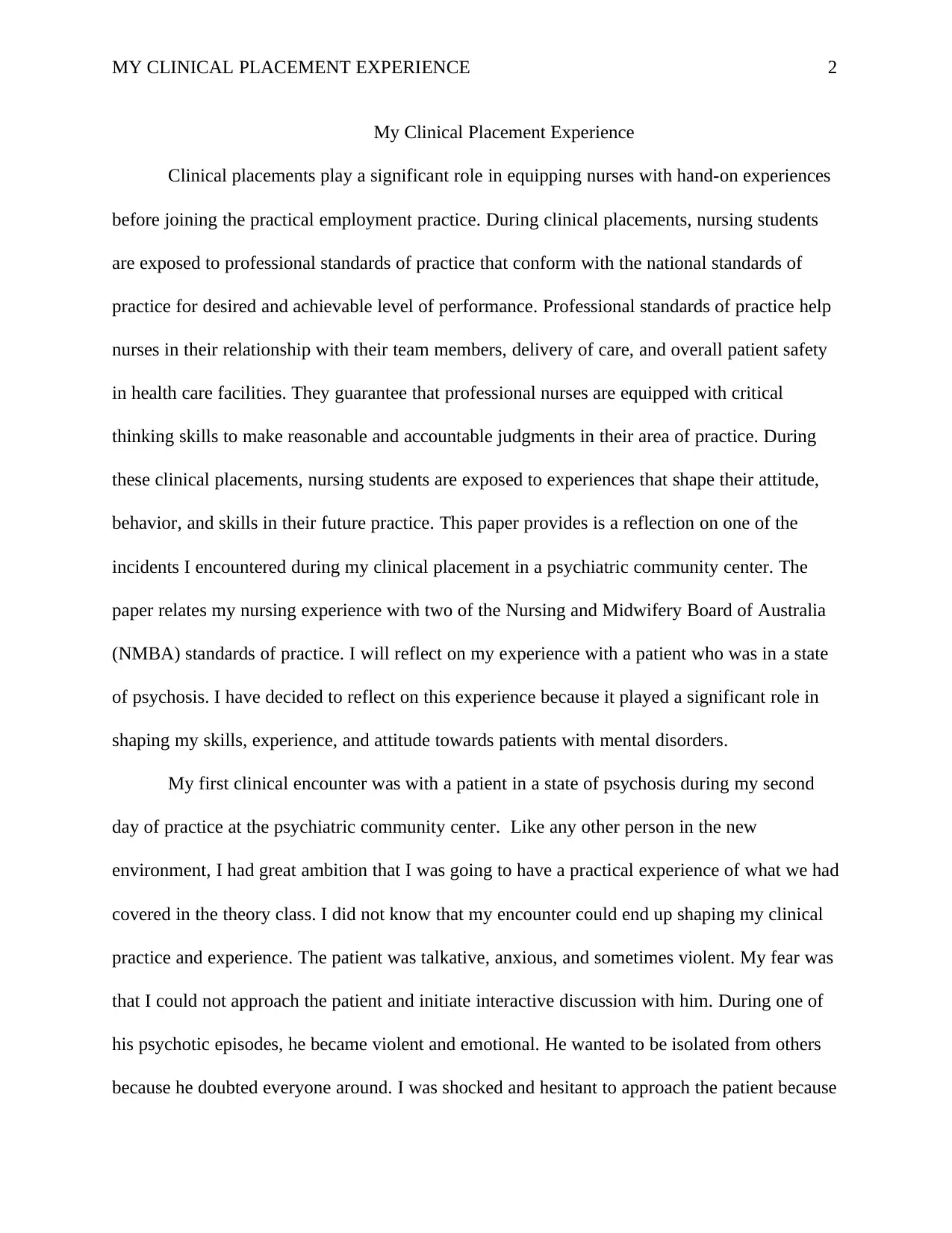
MY CLINICAL PLACEMENT EXPERIENCE 2
My Clinical Placement Experience
Clinical placements play a significant role in equipping nurses with hand-on experiences
before joining the practical employment practice. During clinical placements, nursing students
are exposed to professional standards of practice that conform with the national standards of
practice for desired and achievable level of performance. Professional standards of practice help
nurses in their relationship with their team members, delivery of care, and overall patient safety
in health care facilities. They guarantee that professional nurses are equipped with critical
thinking skills to make reasonable and accountable judgments in their area of practice. During
these clinical placements, nursing students are exposed to experiences that shape their attitude,
behavior, and skills in their future practice. This paper provides is a reflection on one of the
incidents I encountered during my clinical placement in a psychiatric community center. The
paper relates my nursing experience with two of the Nursing and Midwifery Board of Australia
(NMBA) standards of practice. I will reflect on my experience with a patient who was in a state
of psychosis. I have decided to reflect on this experience because it played a significant role in
shaping my skills, experience, and attitude towards patients with mental disorders.
My first clinical encounter was with a patient in a state of psychosis during my second
day of practice at the psychiatric community center. Like any other person in the new
environment, I had great ambition that I was going to have a practical experience of what we had
covered in the theory class. I did not know that my encounter could end up shaping my clinical
practice and experience. The patient was talkative, anxious, and sometimes violent. My fear was
that I could not approach the patient and initiate interactive discussion with him. During one of
his psychotic episodes, he became violent and emotional. He wanted to be isolated from others
because he doubted everyone around. I was shocked and hesitant to approach the patient because
My Clinical Placement Experience
Clinical placements play a significant role in equipping nurses with hand-on experiences
before joining the practical employment practice. During clinical placements, nursing students
are exposed to professional standards of practice that conform with the national standards of
practice for desired and achievable level of performance. Professional standards of practice help
nurses in their relationship with their team members, delivery of care, and overall patient safety
in health care facilities. They guarantee that professional nurses are equipped with critical
thinking skills to make reasonable and accountable judgments in their area of practice. During
these clinical placements, nursing students are exposed to experiences that shape their attitude,
behavior, and skills in their future practice. This paper provides is a reflection on one of the
incidents I encountered during my clinical placement in a psychiatric community center. The
paper relates my nursing experience with two of the Nursing and Midwifery Board of Australia
(NMBA) standards of practice. I will reflect on my experience with a patient who was in a state
of psychosis. I have decided to reflect on this experience because it played a significant role in
shaping my skills, experience, and attitude towards patients with mental disorders.
My first clinical encounter was with a patient in a state of psychosis during my second
day of practice at the psychiatric community center. Like any other person in the new
environment, I had great ambition that I was going to have a practical experience of what we had
covered in the theory class. I did not know that my encounter could end up shaping my clinical
practice and experience. The patient was talkative, anxious, and sometimes violent. My fear was
that I could not approach the patient and initiate interactive discussion with him. During one of
his psychotic episodes, he became violent and emotional. He wanted to be isolated from others
because he doubted everyone around. I was shocked and hesitant to approach the patient because
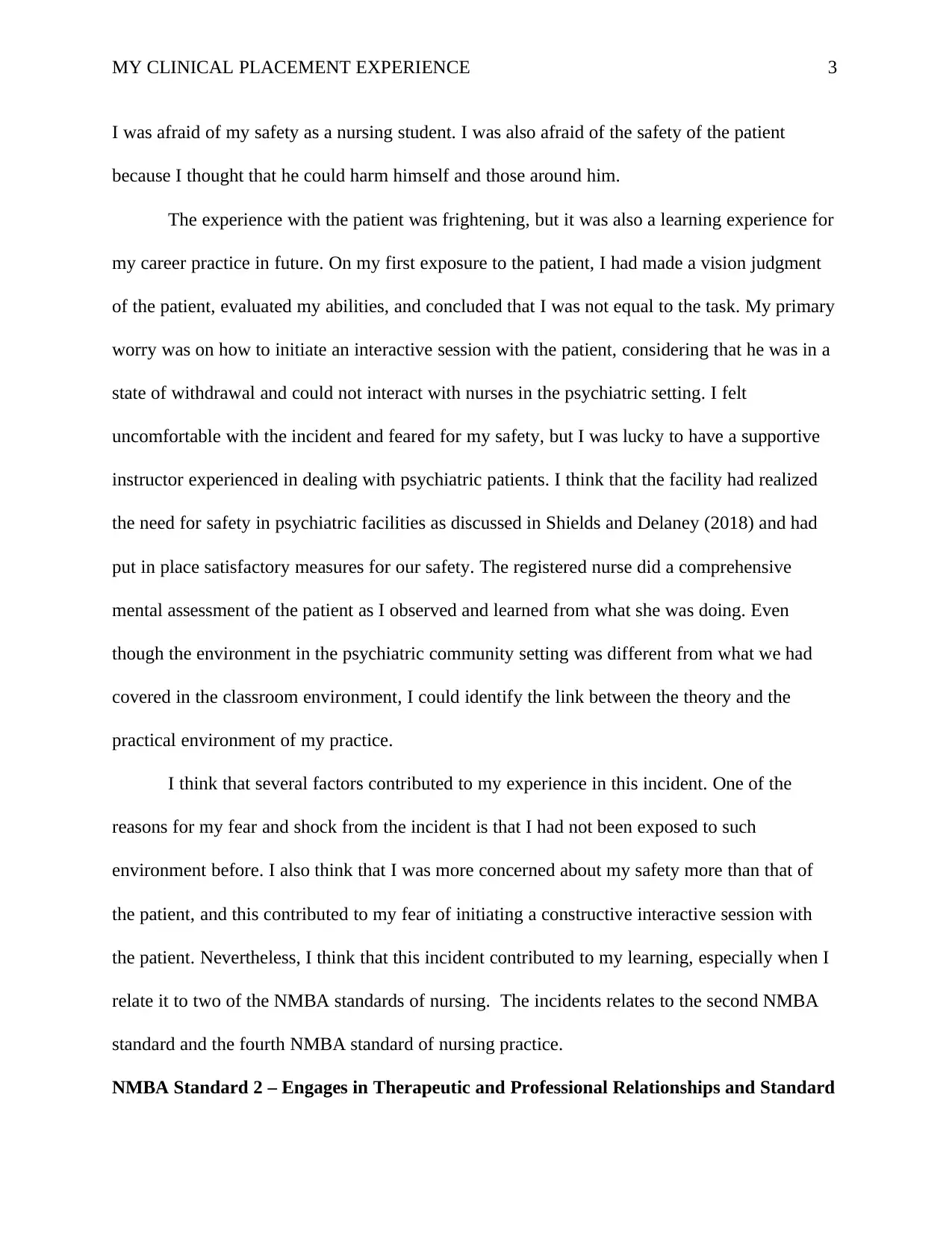
MY CLINICAL PLACEMENT EXPERIENCE 3
I was afraid of my safety as a nursing student. I was also afraid of the safety of the patient
because I thought that he could harm himself and those around him.
The experience with the patient was frightening, but it was also a learning experience for
my career practice in future. On my first exposure to the patient, I had made a vision judgment
of the patient, evaluated my abilities, and concluded that I was not equal to the task. My primary
worry was on how to initiate an interactive session with the patient, considering that he was in a
state of withdrawal and could not interact with nurses in the psychiatric setting. I felt
uncomfortable with the incident and feared for my safety, but I was lucky to have a supportive
instructor experienced in dealing with psychiatric patients. I think that the facility had realized
the need for safety in psychiatric facilities as discussed in Shields and Delaney (2018) and had
put in place satisfactory measures for our safety. The registered nurse did a comprehensive
mental assessment of the patient as I observed and learned from what she was doing. Even
though the environment in the psychiatric community setting was different from what we had
covered in the classroom environment, I could identify the link between the theory and the
practical environment of my practice.
I think that several factors contributed to my experience in this incident. One of the
reasons for my fear and shock from the incident is that I had not been exposed to such
environment before. I also think that I was more concerned about my safety more than that of
the patient, and this contributed to my fear of initiating a constructive interactive session with
the patient. Nevertheless, I think that this incident contributed to my learning, especially when I
relate it to two of the NMBA standards of nursing. The incidents relates to the second NMBA
standard and the fourth NMBA standard of nursing practice.
NMBA Standard 2 – Engages in Therapeutic and Professional Relationships and Standard
I was afraid of my safety as a nursing student. I was also afraid of the safety of the patient
because I thought that he could harm himself and those around him.
The experience with the patient was frightening, but it was also a learning experience for
my career practice in future. On my first exposure to the patient, I had made a vision judgment
of the patient, evaluated my abilities, and concluded that I was not equal to the task. My primary
worry was on how to initiate an interactive session with the patient, considering that he was in a
state of withdrawal and could not interact with nurses in the psychiatric setting. I felt
uncomfortable with the incident and feared for my safety, but I was lucky to have a supportive
instructor experienced in dealing with psychiatric patients. I think that the facility had realized
the need for safety in psychiatric facilities as discussed in Shields and Delaney (2018) and had
put in place satisfactory measures for our safety. The registered nurse did a comprehensive
mental assessment of the patient as I observed and learned from what she was doing. Even
though the environment in the psychiatric community setting was different from what we had
covered in the classroom environment, I could identify the link between the theory and the
practical environment of my practice.
I think that several factors contributed to my experience in this incident. One of the
reasons for my fear and shock from the incident is that I had not been exposed to such
environment before. I also think that I was more concerned about my safety more than that of
the patient, and this contributed to my fear of initiating a constructive interactive session with
the patient. Nevertheless, I think that this incident contributed to my learning, especially when I
relate it to two of the NMBA standards of nursing. The incidents relates to the second NMBA
standard and the fourth NMBA standard of nursing practice.
NMBA Standard 2 – Engages in Therapeutic and Professional Relationships and Standard
⊘ This is a preview!⊘
Do you want full access?
Subscribe today to unlock all pages.

Trusted by 1+ million students worldwide
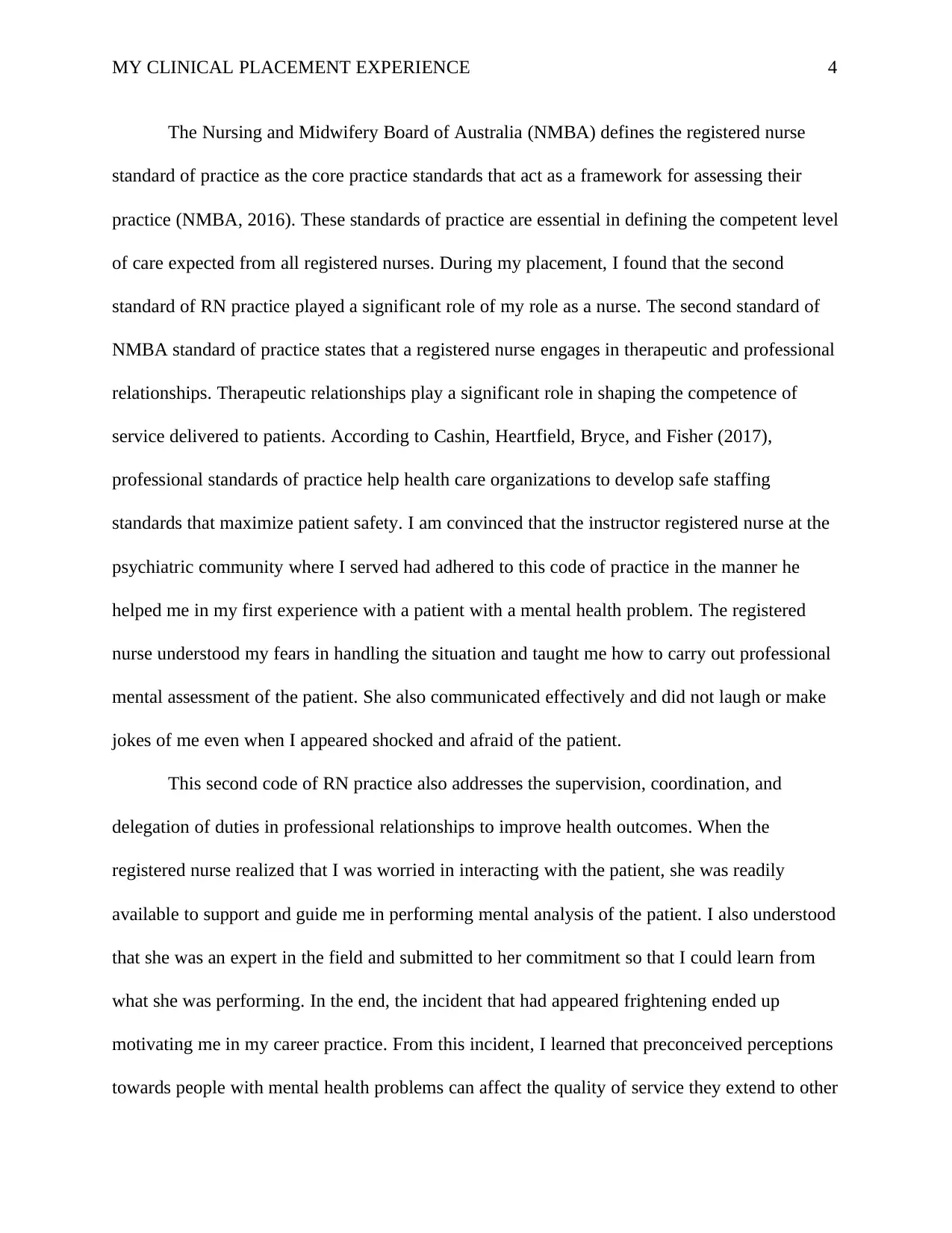
MY CLINICAL PLACEMENT EXPERIENCE 4
The Nursing and Midwifery Board of Australia (NMBA) defines the registered nurse
standard of practice as the core practice standards that act as a framework for assessing their
practice (NMBA, 2016). These standards of practice are essential in defining the competent level
of care expected from all registered nurses. During my placement, I found that the second
standard of RN practice played a significant role of my role as a nurse. The second standard of
NMBA standard of practice states that a registered nurse engages in therapeutic and professional
relationships. Therapeutic relationships play a significant role in shaping the competence of
service delivered to patients. According to Cashin, Heartfield, Bryce, and Fisher (2017),
professional standards of practice help health care organizations to develop safe staffing
standards that maximize patient safety. I am convinced that the instructor registered nurse at the
psychiatric community where I served had adhered to this code of practice in the manner he
helped me in my first experience with a patient with a mental health problem. The registered
nurse understood my fears in handling the situation and taught me how to carry out professional
mental assessment of the patient. She also communicated effectively and did not laugh or make
jokes of me even when I appeared shocked and afraid of the patient.
This second code of RN practice also addresses the supervision, coordination, and
delegation of duties in professional relationships to improve health outcomes. When the
registered nurse realized that I was worried in interacting with the patient, she was readily
available to support and guide me in performing mental analysis of the patient. I also understood
that she was an expert in the field and submitted to her commitment so that I could learn from
what she was performing. In the end, the incident that had appeared frightening ended up
motivating me in my career practice. From this incident, I learned that preconceived perceptions
towards people with mental health problems can affect the quality of service they extend to other
The Nursing and Midwifery Board of Australia (NMBA) defines the registered nurse
standard of practice as the core practice standards that act as a framework for assessing their
practice (NMBA, 2016). These standards of practice are essential in defining the competent level
of care expected from all registered nurses. During my placement, I found that the second
standard of RN practice played a significant role of my role as a nurse. The second standard of
NMBA standard of practice states that a registered nurse engages in therapeutic and professional
relationships. Therapeutic relationships play a significant role in shaping the competence of
service delivered to patients. According to Cashin, Heartfield, Bryce, and Fisher (2017),
professional standards of practice help health care organizations to develop safe staffing
standards that maximize patient safety. I am convinced that the instructor registered nurse at the
psychiatric community where I served had adhered to this code of practice in the manner he
helped me in my first experience with a patient with a mental health problem. The registered
nurse understood my fears in handling the situation and taught me how to carry out professional
mental assessment of the patient. She also communicated effectively and did not laugh or make
jokes of me even when I appeared shocked and afraid of the patient.
This second code of RN practice also addresses the supervision, coordination, and
delegation of duties in professional relationships to improve health outcomes. When the
registered nurse realized that I was worried in interacting with the patient, she was readily
available to support and guide me in performing mental analysis of the patient. I also understood
that she was an expert in the field and submitted to her commitment so that I could learn from
what she was performing. In the end, the incident that had appeared frightening ended up
motivating me in my career practice. From this incident, I learned that preconceived perceptions
towards people with mental health problems can affect the quality of service they extend to other
Paraphrase This Document
Need a fresh take? Get an instant paraphrase of this document with our AI Paraphraser
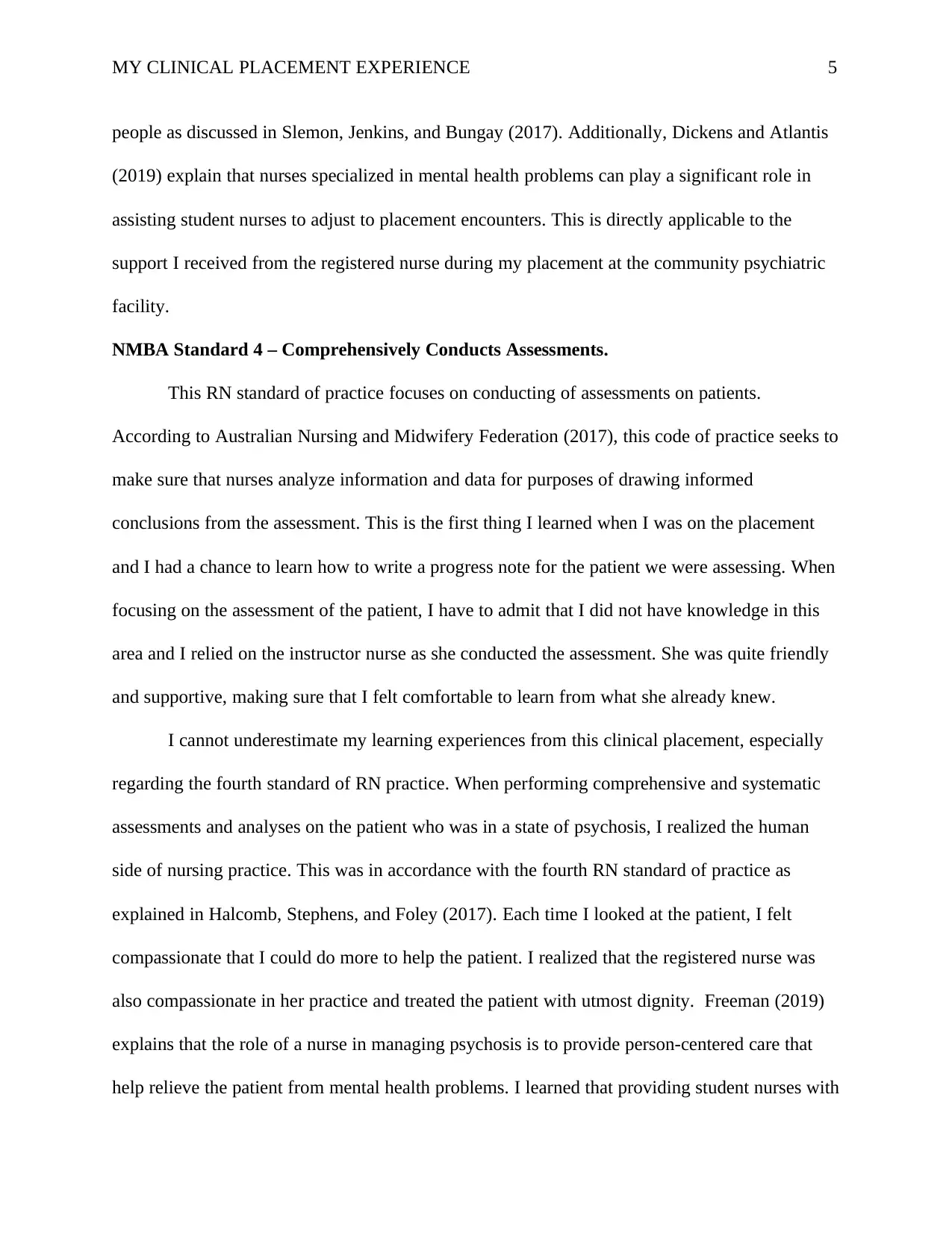
MY CLINICAL PLACEMENT EXPERIENCE 5
people as discussed in Slemon, Jenkins, and Bungay (2017). Additionally, Dickens and Atlantis
(2019) explain that nurses specialized in mental health problems can play a significant role in
assisting student nurses to adjust to placement encounters. This is directly applicable to the
support I received from the registered nurse during my placement at the community psychiatric
facility.
NMBA Standard 4 – Comprehensively Conducts Assessments.
This RN standard of practice focuses on conducting of assessments on patients.
According to Australian Nursing and Midwifery Federation (2017), this code of practice seeks to
make sure that nurses analyze information and data for purposes of drawing informed
conclusions from the assessment. This is the first thing I learned when I was on the placement
and I had a chance to learn how to write a progress note for the patient we were assessing. When
focusing on the assessment of the patient, I have to admit that I did not have knowledge in this
area and I relied on the instructor nurse as she conducted the assessment. She was quite friendly
and supportive, making sure that I felt comfortable to learn from what she already knew.
I cannot underestimate my learning experiences from this clinical placement, especially
regarding the fourth standard of RN practice. When performing comprehensive and systematic
assessments and analyses on the patient who was in a state of psychosis, I realized the human
side of nursing practice. This was in accordance with the fourth RN standard of practice as
explained in Halcomb, Stephens, and Foley (2017). Each time I looked at the patient, I felt
compassionate that I could do more to help the patient. I realized that the registered nurse was
also compassionate in her practice and treated the patient with utmost dignity. Freeman (2019)
explains that the role of a nurse in managing psychosis is to provide person-centered care that
help relieve the patient from mental health problems. I learned that providing student nurses with
people as discussed in Slemon, Jenkins, and Bungay (2017). Additionally, Dickens and Atlantis
(2019) explain that nurses specialized in mental health problems can play a significant role in
assisting student nurses to adjust to placement encounters. This is directly applicable to the
support I received from the registered nurse during my placement at the community psychiatric
facility.
NMBA Standard 4 – Comprehensively Conducts Assessments.
This RN standard of practice focuses on conducting of assessments on patients.
According to Australian Nursing and Midwifery Federation (2017), this code of practice seeks to
make sure that nurses analyze information and data for purposes of drawing informed
conclusions from the assessment. This is the first thing I learned when I was on the placement
and I had a chance to learn how to write a progress note for the patient we were assessing. When
focusing on the assessment of the patient, I have to admit that I did not have knowledge in this
area and I relied on the instructor nurse as she conducted the assessment. She was quite friendly
and supportive, making sure that I felt comfortable to learn from what she already knew.
I cannot underestimate my learning experiences from this clinical placement, especially
regarding the fourth standard of RN practice. When performing comprehensive and systematic
assessments and analyses on the patient who was in a state of psychosis, I realized the human
side of nursing practice. This was in accordance with the fourth RN standard of practice as
explained in Halcomb, Stephens, and Foley (2017). Each time I looked at the patient, I felt
compassionate that I could do more to help the patient. I realized that the registered nurse was
also compassionate in her practice and treated the patient with utmost dignity. Freeman (2019)
explains that the role of a nurse in managing psychosis is to provide person-centered care that
help relieve the patient from mental health problems. I learned that providing student nurses with
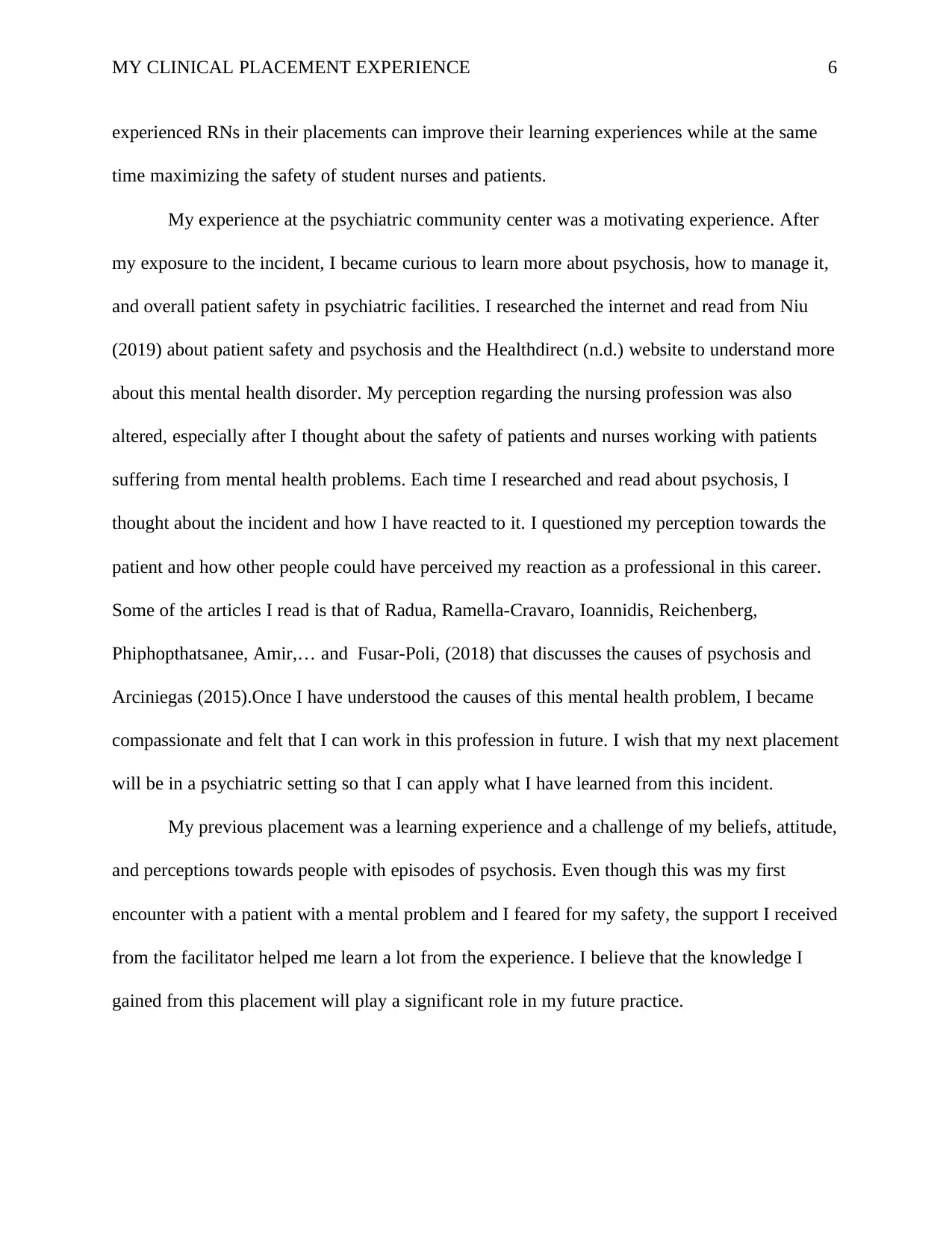
MY CLINICAL PLACEMENT EXPERIENCE 6
experienced RNs in their placements can improve their learning experiences while at the same
time maximizing the safety of student nurses and patients.
My experience at the psychiatric community center was a motivating experience. After
my exposure to the incident, I became curious to learn more about psychosis, how to manage it,
and overall patient safety in psychiatric facilities. I researched the internet and read from Niu
(2019) about patient safety and psychosis and the Healthdirect (n.d.) website to understand more
about this mental health disorder. My perception regarding the nursing profession was also
altered, especially after I thought about the safety of patients and nurses working with patients
suffering from mental health problems. Each time I researched and read about psychosis, I
thought about the incident and how I have reacted to it. I questioned my perception towards the
patient and how other people could have perceived my reaction as a professional in this career.
Some of the articles I read is that of Radua, Ramella-Cravaro, Ioannidis, Reichenberg,
Phiphopthatsanee, Amir,… and Fusar-Poli, (2018) that discusses the causes of psychosis and
Arciniegas (2015).Once I have understood the causes of this mental health problem, I became
compassionate and felt that I can work in this profession in future. I wish that my next placement
will be in a psychiatric setting so that I can apply what I have learned from this incident.
My previous placement was a learning experience and a challenge of my beliefs, attitude,
and perceptions towards people with episodes of psychosis. Even though this was my first
encounter with a patient with a mental problem and I feared for my safety, the support I received
from the facilitator helped me learn a lot from the experience. I believe that the knowledge I
gained from this placement will play a significant role in my future practice.
experienced RNs in their placements can improve their learning experiences while at the same
time maximizing the safety of student nurses and patients.
My experience at the psychiatric community center was a motivating experience. After
my exposure to the incident, I became curious to learn more about psychosis, how to manage it,
and overall patient safety in psychiatric facilities. I researched the internet and read from Niu
(2019) about patient safety and psychosis and the Healthdirect (n.d.) website to understand more
about this mental health disorder. My perception regarding the nursing profession was also
altered, especially after I thought about the safety of patients and nurses working with patients
suffering from mental health problems. Each time I researched and read about psychosis, I
thought about the incident and how I have reacted to it. I questioned my perception towards the
patient and how other people could have perceived my reaction as a professional in this career.
Some of the articles I read is that of Radua, Ramella-Cravaro, Ioannidis, Reichenberg,
Phiphopthatsanee, Amir,… and Fusar-Poli, (2018) that discusses the causes of psychosis and
Arciniegas (2015).Once I have understood the causes of this mental health problem, I became
compassionate and felt that I can work in this profession in future. I wish that my next placement
will be in a psychiatric setting so that I can apply what I have learned from this incident.
My previous placement was a learning experience and a challenge of my beliefs, attitude,
and perceptions towards people with episodes of psychosis. Even though this was my first
encounter with a patient with a mental problem and I feared for my safety, the support I received
from the facilitator helped me learn a lot from the experience. I believe that the knowledge I
gained from this placement will play a significant role in my future practice.
⊘ This is a preview!⊘
Do you want full access?
Subscribe today to unlock all pages.

Trusted by 1+ million students worldwide
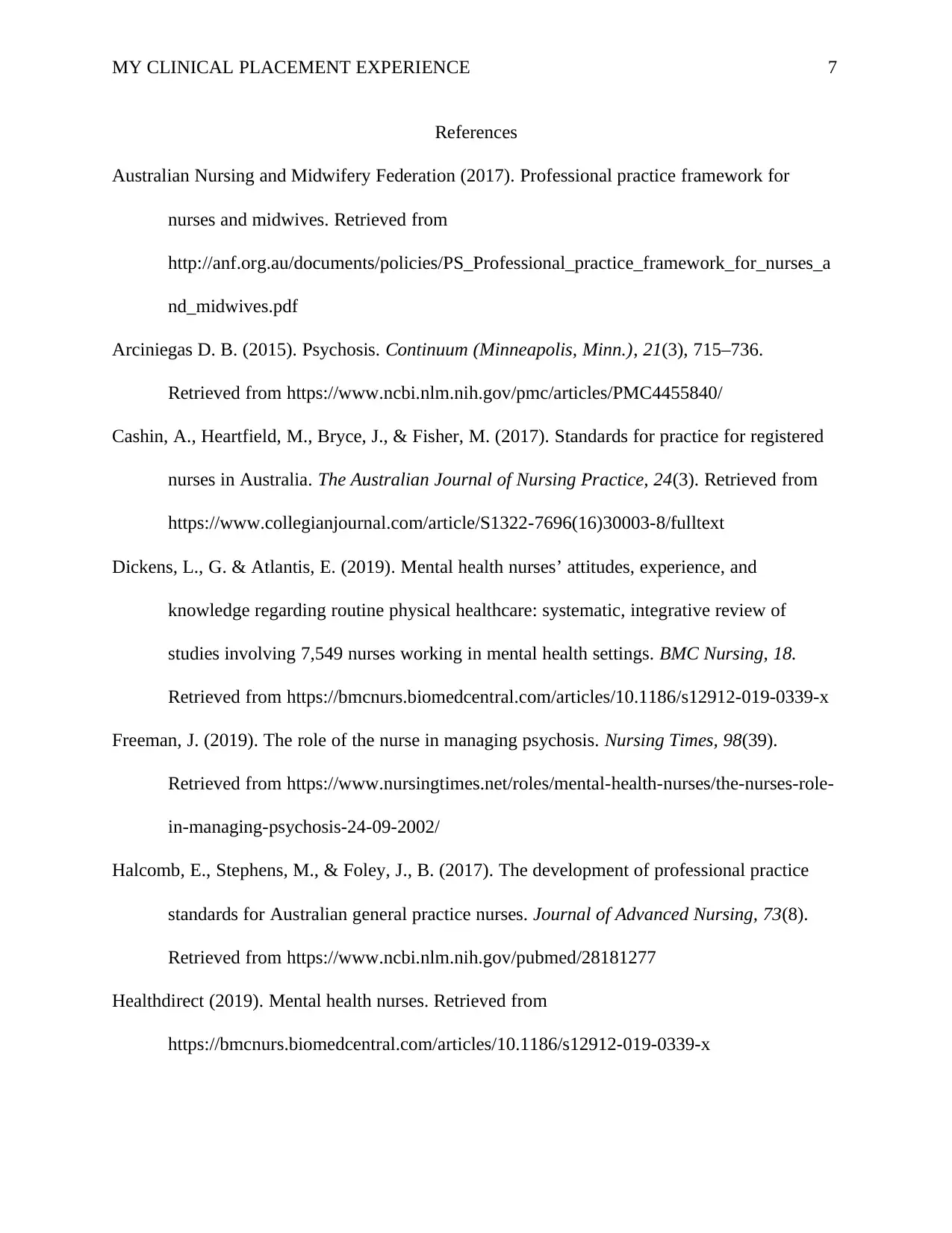
MY CLINICAL PLACEMENT EXPERIENCE 7
References
Australian Nursing and Midwifery Federation (2017). Professional practice framework for
nurses and midwives. Retrieved from
http://anf.org.au/documents/policies/PS_Professional_practice_framework_for_nurses_a
nd_midwives.pdf
Arciniegas D. B. (2015). Psychosis. Continuum (Minneapolis, Minn.), 21(3), 715–736.
Retrieved from https://www.ncbi.nlm.nih.gov/pmc/articles/PMC4455840/
Cashin, A., Heartfield, M., Bryce, J., & Fisher, M. (2017). Standards for practice for registered
nurses in Australia. The Australian Journal of Nursing Practice, 24(3). Retrieved from
https://www.collegianjournal.com/article/S1322-7696(16)30003-8/fulltext
Dickens, L., G. & Atlantis, E. (2019). Mental health nurses’ attitudes, experience, and
knowledge regarding routine physical healthcare: systematic, integrative review of
studies involving 7,549 nurses working in mental health settings. BMC Nursing, 18.
Retrieved from https://bmcnurs.biomedcentral.com/articles/10.1186/s12912-019-0339-x
Freeman, J. (2019). The role of the nurse in managing psychosis. Nursing Times, 98(39).
Retrieved from https://www.nursingtimes.net/roles/mental-health-nurses/the-nurses-role-
in-managing-psychosis-24-09-2002/
Halcomb, E., Stephens, M., & Foley, J., B. (2017). The development of professional practice
standards for Australian general practice nurses. Journal of Advanced Nursing, 73(8).
Retrieved from https://www.ncbi.nlm.nih.gov/pubmed/28181277
Healthdirect (2019). Mental health nurses. Retrieved from
https://bmcnurs.biomedcentral.com/articles/10.1186/s12912-019-0339-x
References
Australian Nursing and Midwifery Federation (2017). Professional practice framework for
nurses and midwives. Retrieved from
http://anf.org.au/documents/policies/PS_Professional_practice_framework_for_nurses_a
nd_midwives.pdf
Arciniegas D. B. (2015). Psychosis. Continuum (Minneapolis, Minn.), 21(3), 715–736.
Retrieved from https://www.ncbi.nlm.nih.gov/pmc/articles/PMC4455840/
Cashin, A., Heartfield, M., Bryce, J., & Fisher, M. (2017). Standards for practice for registered
nurses in Australia. The Australian Journal of Nursing Practice, 24(3). Retrieved from
https://www.collegianjournal.com/article/S1322-7696(16)30003-8/fulltext
Dickens, L., G. & Atlantis, E. (2019). Mental health nurses’ attitudes, experience, and
knowledge regarding routine physical healthcare: systematic, integrative review of
studies involving 7,549 nurses working in mental health settings. BMC Nursing, 18.
Retrieved from https://bmcnurs.biomedcentral.com/articles/10.1186/s12912-019-0339-x
Freeman, J. (2019). The role of the nurse in managing psychosis. Nursing Times, 98(39).
Retrieved from https://www.nursingtimes.net/roles/mental-health-nurses/the-nurses-role-
in-managing-psychosis-24-09-2002/
Halcomb, E., Stephens, M., & Foley, J., B. (2017). The development of professional practice
standards for Australian general practice nurses. Journal of Advanced Nursing, 73(8).
Retrieved from https://www.ncbi.nlm.nih.gov/pubmed/28181277
Healthdirect (2019). Mental health nurses. Retrieved from
https://bmcnurs.biomedcentral.com/articles/10.1186/s12912-019-0339-x
Paraphrase This Document
Need a fresh take? Get an instant paraphrase of this document with our AI Paraphraser
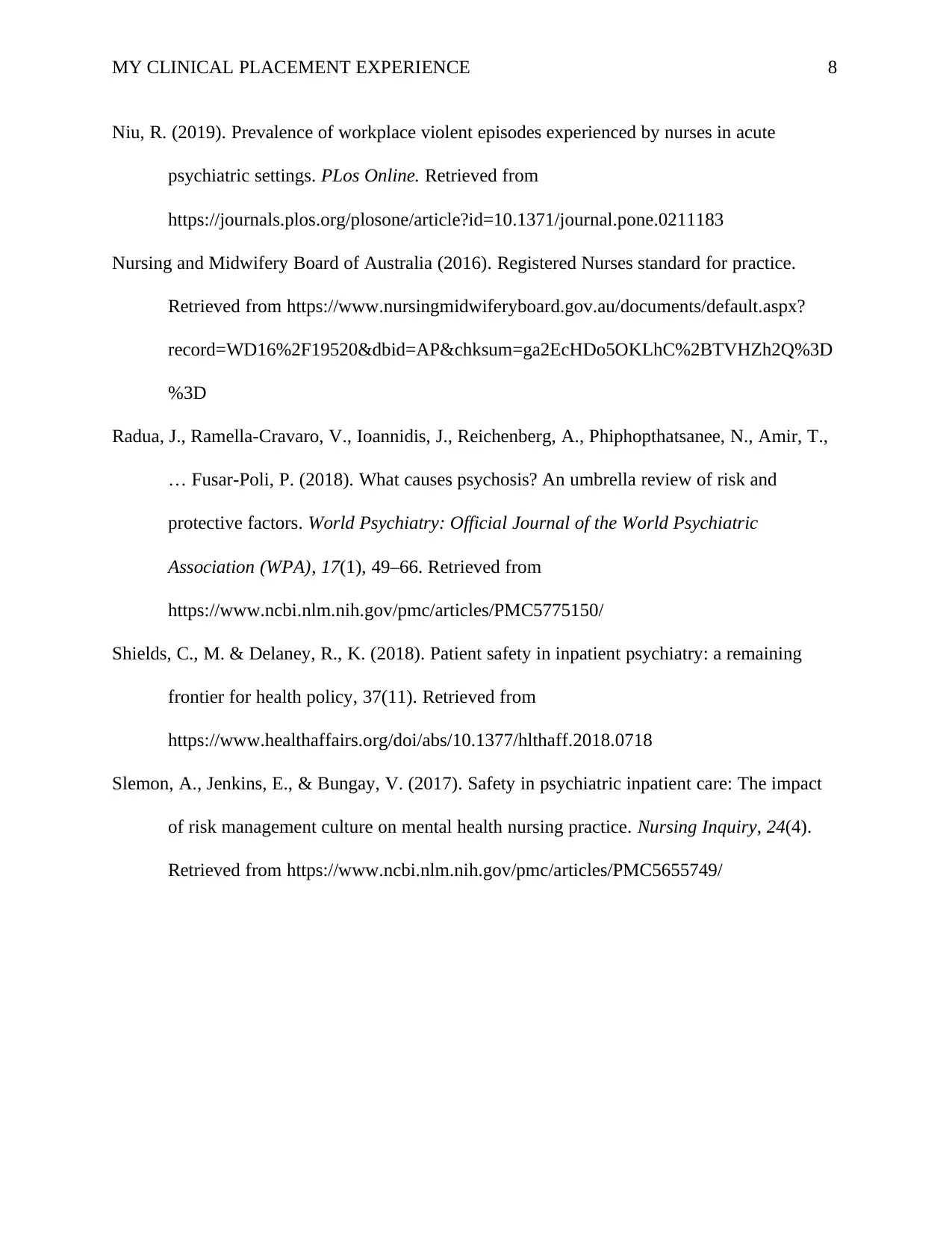
MY CLINICAL PLACEMENT EXPERIENCE 8
Niu, R. (2019). Prevalence of workplace violent episodes experienced by nurses in acute
psychiatric settings. PLos Online. Retrieved from
https://journals.plos.org/plosone/article?id=10.1371/journal.pone.0211183
Nursing and Midwifery Board of Australia (2016). Registered Nurses standard for practice.
Retrieved from https://www.nursingmidwiferyboard.gov.au/documents/default.aspx?
record=WD16%2F19520&dbid=AP&chksum=ga2EcHDo5OKLhC%2BTVHZh2Q%3D
%3D
Radua, J., Ramella-Cravaro, V., Ioannidis, J., Reichenberg, A., Phiphopthatsanee, N., Amir, T.,
… Fusar-Poli, P. (2018). What causes psychosis? An umbrella review of risk and
protective factors. World Psychiatry: Official Journal of the World Psychiatric
Association (WPA), 17(1), 49–66. Retrieved from
https://www.ncbi.nlm.nih.gov/pmc/articles/PMC5775150/
Shields, C., M. & Delaney, R., K. (2018). Patient safety in inpatient psychiatry: a remaining
frontier for health policy, 37(11). Retrieved from
https://www.healthaffairs.org/doi/abs/10.1377/hlthaff.2018.0718
Slemon, A., Jenkins, E., & Bungay, V. (2017). Safety in psychiatric inpatient care: The impact
of risk management culture on mental health nursing practice. Nursing Inquiry, 24(4).
Retrieved from https://www.ncbi.nlm.nih.gov/pmc/articles/PMC5655749/
Niu, R. (2019). Prevalence of workplace violent episodes experienced by nurses in acute
psychiatric settings. PLos Online. Retrieved from
https://journals.plos.org/plosone/article?id=10.1371/journal.pone.0211183
Nursing and Midwifery Board of Australia (2016). Registered Nurses standard for practice.
Retrieved from https://www.nursingmidwiferyboard.gov.au/documents/default.aspx?
record=WD16%2F19520&dbid=AP&chksum=ga2EcHDo5OKLhC%2BTVHZh2Q%3D
%3D
Radua, J., Ramella-Cravaro, V., Ioannidis, J., Reichenberg, A., Phiphopthatsanee, N., Amir, T.,
… Fusar-Poli, P. (2018). What causes psychosis? An umbrella review of risk and
protective factors. World Psychiatry: Official Journal of the World Psychiatric
Association (WPA), 17(1), 49–66. Retrieved from
https://www.ncbi.nlm.nih.gov/pmc/articles/PMC5775150/
Shields, C., M. & Delaney, R., K. (2018). Patient safety in inpatient psychiatry: a remaining
frontier for health policy, 37(11). Retrieved from
https://www.healthaffairs.org/doi/abs/10.1377/hlthaff.2018.0718
Slemon, A., Jenkins, E., & Bungay, V. (2017). Safety in psychiatric inpatient care: The impact
of risk management culture on mental health nursing practice. Nursing Inquiry, 24(4).
Retrieved from https://www.ncbi.nlm.nih.gov/pmc/articles/PMC5655749/
1 out of 8
Related Documents
Your All-in-One AI-Powered Toolkit for Academic Success.
+13062052269
info@desklib.com
Available 24*7 on WhatsApp / Email
![[object Object]](/_next/static/media/star-bottom.7253800d.svg)
Unlock your academic potential
Copyright © 2020–2025 A2Z Services. All Rights Reserved. Developed and managed by ZUCOL.





